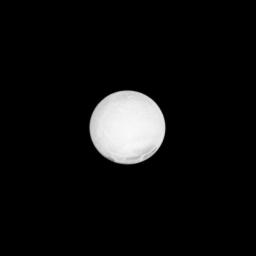Enceladus at Low Phase
Caption:
The highly reflective surface of Saturn's moon Enceladus is almost completely illuminated in this Cassini spacecraft image taken at a low phase angle.
The phase angle, or Sun-Enceladus-spacecraft angle, for this view is 2 degrees. Enceladus is one of the most reflective bodies in the solar system because it is constantly coated by fresh, white ice particles. See
PIA10500
and
PIA05422
to learn more.
This view looks toward the trailing hemisphere of Enceladus (504 kilometers, or 313 miles across). North on Enceladus is up. The view was acquired at a distance of approximately 423,000 kilometers (263,000 miles) from Enceladus. The image was taken in visible light with the Cassini spacecraft narrow-angle camera on Oct. 14, 2009. Image scale is 3 kilometers (2 miles) per pixel.
Background Info:
The Cassini-Huygens mission is a cooperative project of NASA, the European Space Agency and the Italian Space Agency. The Jet Propulsion Laboratory, a division of the California Institute of Technology in Pasadena, manages the mission for NASA's Science Mission Directorate, Washington, D.C. The Cassini orbiter and its two onboard cameras were designed, developed and assembled at JPL. The imaging operations center is based at the Space Science Institute in Boulder, Colo.
For more information about the Cassini-Huygens mission visit
http://saturn.jpl.nasa.gov/
. The Cassini imaging team homepage is at
http://ciclops.org
.
Cataloging Keywords:
| Name |
Value |
Additional Values |
| Target |
Enceladus |
|
| System |
Saturn |
|
| Target Type |
Satellite |
|
| Mission |
Cassini-Huygens |
|
| Instrument Host |
Cassini Orbiter |
|
| Host Type |
Orbiter |
|
| Instrument |
Imaging Science Subsystem (ISS) |
|
| Detector |
Narrow Angle Camera |
|
| Extra Keywords |
Grayscale, Visual |
| Acquisition Date |
|
| Release Date |
2010-06-22 |
| Date in Caption |
2009-10-14 |
|
| Image Credit |
NASA/JPL/Space Science Institute |
| Source |
photojournal.jpl.nasa.gov/catalog/PIA12660 |
| Identifier |
PIA12660 |

 Planetary Data System
Planetary Data System
